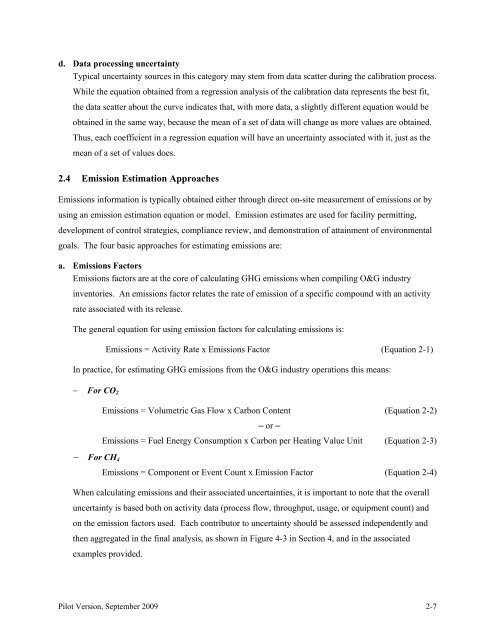addressing uncertainty in oil and natural gas industry greenhouse
addressing uncertainty in oil and natural gas industry greenhouse
addressing uncertainty in oil and natural gas industry greenhouse
You also want an ePaper? Increase the reach of your titles
YUMPU automatically turns print PDFs into web optimized ePapers that Google loves.
d. Data process<strong>in</strong>g <strong>uncerta<strong>in</strong>ty</strong><br />
Typical <strong>uncerta<strong>in</strong>ty</strong> sources <strong>in</strong> this category may stem from data scatter dur<strong>in</strong>g the calibration process.<br />
While the equation obta<strong>in</strong>ed from a regression analysis of the calibration data represents the best fit,<br />
the data scatter about the curve <strong>in</strong>dicates that, with more data, a slightly different equation would be<br />
obta<strong>in</strong>ed <strong>in</strong> the same way, because the mean of a set of data will change as more values are obta<strong>in</strong>ed.<br />
Thus, each coefficient <strong>in</strong> a regression equation will have an <strong>uncerta<strong>in</strong>ty</strong> associated with it, just as the<br />
mean of a set of values does.<br />
2.4 Emission Estimation Approaches<br />
Emissions <strong>in</strong>formation is typically obta<strong>in</strong>ed either through direct on-site measurement of emissions or by<br />
us<strong>in</strong>g an emission estimation equation or model. Emission estimates are used for facility permitt<strong>in</strong>g,<br />
development of control strategies, compliance review, <strong>and</strong> demonstration of atta<strong>in</strong>ment of environmental<br />
goals. The four basic approaches for estimat<strong>in</strong>g emissions are:<br />
a. Emissions Factors<br />
Emissions factors are at the core of calculat<strong>in</strong>g GHG emissions when compil<strong>in</strong>g O&G <strong>in</strong>dustry<br />
<strong>in</strong>ventories. An emissions factor relates the rate of emission of a specific compound with an activity<br />
rate associated with its release.<br />
The general equation for us<strong>in</strong>g emission factors for calculat<strong>in</strong>g emissions is:<br />
Emissions = Activity Rate x Emissions Factor (Equation 2-1)<br />
In practice, for estimat<strong>in</strong>g GHG emissions from the O&G <strong>in</strong>dustry operations this means:<br />
− For CO 2<br />
Emissions = Volumetric Gas Flow x Carbon Content (Equation 2-2)<br />
– or –<br />
Emissions = Fuel Energy Consumption x Carbon per Heat<strong>in</strong>g Value Unit (Equation 2-3)<br />
− For CH 4<br />
Emissions = Component or Event Count x Emission Factor (Equation 2-4)<br />
When calculat<strong>in</strong>g emissions <strong>and</strong> their associated uncerta<strong>in</strong>ties, it is important to note that the overall<br />
<strong>uncerta<strong>in</strong>ty</strong> is based both on activity data (process flow, throughput, usage, or equipment count) <strong>and</strong><br />
on the emission factors used. Each contributor to <strong>uncerta<strong>in</strong>ty</strong> should be assessed <strong>in</strong>dependently <strong>and</strong><br />
then aggregated <strong>in</strong> the f<strong>in</strong>al analysis, as shown <strong>in</strong> Figure 4-3 <strong>in</strong> Section 4, <strong>and</strong> <strong>in</strong> the associated<br />
examples provided.<br />
Pilot Version, September 2009 2-7

















